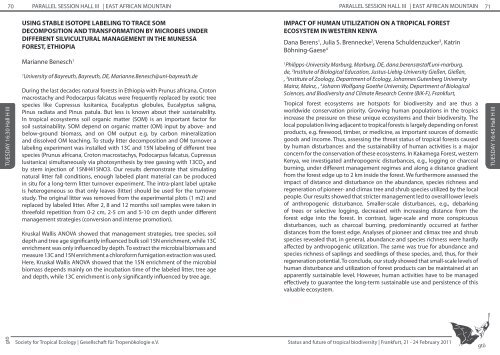Abstract booklet - gtö – Society for Tropical Ecology
Abstract booklet - gtö – Society for Tropical Ecology
Abstract booklet - gtö – Society for Tropical Ecology
Create successful ePaper yourself
Turn your PDF publications into a flip-book with our unique Google optimized e-Paper software.
70 PARALLEL SESSION HALL III | EAST AFRICAN MOUNTAINPARALLEL SESSION HALL III | EAST AFRICAN MOUNTAIN 71USING STABLE ISOTOPE LABELING TO TRACE SOMDECOMPOSITION AND TRANSFORMATION BY MICROBES UNDERDIFFERENT SILVICULTURAL MANAGEMENT IN THE MUNESSAFOREST, ETHIOPIAIMPACT OF HUMAN UTILIZATION ON A TROPICAL FORESTECOSYSTEM IN WESTERN KENYADana Berens 1 , Julia S. Brennecke 2 , Verena Schuldenzucker 3 , KatrinBöhning-Gaese 4TUESDAY 16:30 Hall H IIIMarianne Benesch 11University of Bayreuth, Bayreuth, DE, Marianne.Benesch@uni-bayreuth.deDuring the last decades natural <strong>for</strong>ests in Ethiopia with Prunus africana, Crotonmacrostachy and Podocarpus falcatus were frequently replaced by exotic treespecies like Cupressus lusitanica, Eucalyptus globules, Eucalyptus saligna,Pinus radiata and Pinus patula. But less is known about their sustainability.In tropical ecosystems soil organic matter (SOM) is an important factor <strong>for</strong>soil sustainability. SOM depend on organic matter (OM) input by above- andbelow-ground biomass, and on OM output e.g. by carbon mineralizationand dissolved OM leaching. To study litter decomposition and OM turnover alabeling experiment was installed with 13C and 15N labeling of different treespecies (Prunus africana, Croton macrostachys, Podocarpus falcatus, Cupressuslusitanica) simultaneously via photosynthesis by tree gassing with 13CO 2 andby stem injection of 15NH415NO3. Our results demonstrate that simulatingnatural litter fall conditions, enough labeled plant material can be producedin situ <strong>for</strong> a long-term litter turnover experiment. The intra-plant label uptakeis heterogeneous so that only leaves (litter) should be used <strong>for</strong> the turnoverstudy. The original litter was removed from the experimental plots (1 m2) andreplaced by labeled litter. After 2, 8 and 12 months soil samples were taken inthreefold repetition from 0-2 cm, 2-5 cm and 5-10 cm depth under differentmanagement strategies (conversion and intense promotion).Kruskal Wallis ANOVA showed that management strategies, tree species, soildepth and tree age significantly influenced bulk soil 15N enrichment, while 13Cenrichment was only influenced by depth. To extract the microbial biomass andmeasure 13C and 15N enrichment a chloro<strong>for</strong>m fumigation extraction was used.Here, Kruskal Wallis ANOVA showed that the 15N enrichment of the microbialbiomass depends mainly on the incubation time of the labeled litter, tree ageand depth, while 13C enrichment is only significantly influenced by tree age.1Philipps-University Marburg, Marburg, DE, dana.berens@staff.uni-marburg.de, 2 Institute of Biological Education, Justus-Liebig-University Gießen, Gießen,, 3 Institute of Zoology, Department of <strong>Ecology</strong>, Johannes Gutenberg UniversityMainz, Mainz, , 4 Johann Wolfgang Goethe University, Department of BiologicalSciences, and Biodiversity and Climate Research Centre (BiK-F), Frankfurt,<strong>Tropical</strong> <strong>for</strong>est ecosystems are hotspots <strong>for</strong> biodiversity and are thus aworldwide conservation priority. Growing human populations in the tropicsincrease the pressure on these unique ecosystems and their biodiversity. Thelocal population living adjacent to tropical <strong>for</strong>ests is largely depending on <strong>for</strong>estproducts, e.g. firewood, timber, or medicine, as important sources of domesticgoods and income. Thus, assessing the threat status of tropical <strong>for</strong>ests causedby human disturbances and the sustainability of human activities is a majorconcern <strong>for</strong> the conservation of these ecosystems. In Kakamega Forest, westernKenya, we investigated anthropogenic disturbances, e.g., logging or charcoalburning, under different management regimes and along a distance gradientfrom the <strong>for</strong>est edge up to 2 km inside the <strong>for</strong>est. We furthermore assessed theimpact of distance and disturbance on the abundance, species richness andregeneration of pioneer- and climax tree and shrub species utilized by the localpeople. Our results showed that stricter management led to overall lower levelsof anthropogenic disturbance. Smaller-scale disturbances, e.g., debarkingof trees or selective logging, decreased with increasing distance from the<strong>for</strong>est edge into the <strong>for</strong>est. In contrast, lager-scale and more conspicuousdisturbances, such as charcoal burning, predominantly occurred at fartherdistances from the <strong>for</strong>est edge. Analyses of pioneer and climax tree and shrubspecies revealed that, in general, abundance and species richness were hardlyaffected by anthropogenic utilization. The same was true <strong>for</strong> abundance andspecies richness of saplings and seedlings of these species, and, thus, <strong>for</strong> theirregeneration potential. To conclude, our study showed that small-scale levels ofhuman disturbance and utilization of <strong>for</strong>est products can be maintained at anapparently sustainable level. However, human activities have to be managedeffectively to guarantee the long-term sustainable use and persistence of thisvaluable ecosystem.TUESDAY 16:45 Hall H IIIgtö<strong>Society</strong> <strong>for</strong> <strong>Tropical</strong> <strong>Ecology</strong> | Gesellschaft für Tropenökologie e.V. Status and future of tropical biodiversity | Frankfurt, 21 - 24 February 2011gtö












